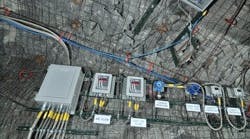Without ventilation, the air in a mine is filled with dangerous contaminants. Miners may work at depths of a mile or more underground where contaminants such as carbon monoxide, as well as the dust created from the mining cycle, exist. Worker safety is essential to any mine’s operation and success, but also presents challenges.
Mining companies must provide fresh air to the workforce to ensure a safe working environment. This airflow is continuously removing and diluting contaminants. The cost of ventilating mines is high and rising even higher as energy prices increase and mines expand in depth. Approximately 50% of a typical mine’s energy costs are associated with ventilation.
[pullquote]Many hard-rock mines contain dozens of main ventilation fans and hundreds of auxiliary ones. Both types are usually controlled manually and operated continuously at maximum speed, or peak capacity, to keep air flowing through each part of the mine 24 hours a day. Unfortunately, keeping all those fans running at maximum speeds, even during non-peak demand periods, wastes precious energy.
Ventilation-on-demand (VOD) systems operate according to the production requirements of a mine, automatically adjusting to peak and non-peak demand periods. Air flows can be directed where and when they are needed for more energy-efficient operation. For example, a diesel loader entering a particular area of a mine may require 100% air volume, but a drill entering a different area of the mine, or in the same area at a different time, may require only 20% air volume. As such, fan speeds can be set so that full performance requirements are met at 5-10% of full motor speed, which reduces power consumption up to 70-90%, compared to fans running at maximum speed. Lower operating speeds also translate into longer motor life, ultimately reducing maintenance and operating costs.
Bestech (www.bestech.com), a provider of system automation to the mining industry in Canada created an approach to help mining companies manage their processes, equipment and energy usage in a safe manner. The NRG1-ECO system combines hardware and software to manage automated equipment in a mine.
“When combined with a VOD module, mining companies can realize significant energy savings,” says Paul Lalonde, product developer — automation, Bestech. “The hardware and software system also can dramatically reduce a mine’s greenhouse gas emissions, while increasing its productivity and air quality.”
Challenge
Bestech formed a consortium of industry experts and organizations to establish best practices and standards. The consortium members include organizations such as the Centre for Mining Excellence, and mining companies such as Vale and Xstrata Nickel.
Vale asked Bestech to tailor a VOD system for its Coleman Mine, which already included some variable frequency drives (VFDs) in its underground equipment. They needed skid-mounted VFDs that could be configured and installed on mine fans and integrated with the system. The project initially began in November 2009.
Rockwell Automation VFDs were selected. System reliability was also a critical issue, as it is for any mine, so that ventilation is available to miners 24/7.
The VOD system is also helping the mine reduce its carbon footprint by 1,577 kg of carbon monoxide for every kW reduction in energy use.
To optimize air flow throughout the mine, the Coleman Mine had an existing system of regulators on each mine level with fresh air fans. On one level of the mine, auxiliary fans are controlled by Allen-Bradley PowerFlex 700H 600-V VFDs on skids underground. The VFDs regulate motor speed and maintain torque levels to match the needs of the load. The VFDs also provide soft-start capability. After the installation of NRG1-ECO, Vale installed the VFDs mounted in a portable e-house on the surface of the mine.
A series of air-flow meters, air temperature sensors, and carbon monoxide detectors also were installed as part of the new system. On one level in the mine, fans, regulators, and air-flow sensors are controlled by Allen Bradley Bulletin 1747 SLC 5/05 PLCs and Allen-Bradley MicroLogix 1400 PLCs.
Using FactoryTalk View human-machine interface (HMI) software faceplates as part of the system, operators can view diagnostic data to access information about system activity and identify and troubleshoot problems.
During system installation, operators pre-set the default parameters for the air flow regulation system in the surface control room. Each entrance into the mine includes its own display to show current air flow, temperature, and carbon monoxide levels. This air quality data is readily available and easily visible at each level of the mine to notify workers of potentially dangerous conditions, such as high carbon monoxide levels or minimum air flow, before entering.
Results
Installation was completed in June 2011. After implementing the VOD system, the mine has realized greater energy savings than the originally anticipated estimate of 30%. The VOD system is also helping the mine reduce its carbon footprint by 1,577 kg of carbon monoxide for every kW reduction in energy use. “Taken all together, these numbers illustrate significant cost savings for the Coleman Mine,” says Lalonde. “We expect to see a savings of approximately $1.4 million in energy costs per year, and the VOD system contributes greatly to this overall savings. The VOD system is also helping to save about 3 million kWh, or 540 tons of carbon monoxide per year.”
The NRG1-ECO also integrates with the Coleman Mine’s tracking system, which helps mine operators detect the location of personnel in an emergency situation through tagging. Tagging also allows mine operators to ramp down or turn off the fans if no one is detected in a certain area of the mine, decreasing energy consumption but also helping keep workers safe. Safety engineers can also use the system to understand the air quality at any given time using real-time data.
